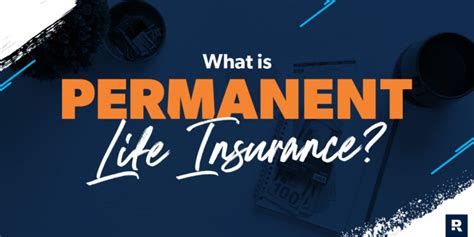What's Life Insurance

Life insurance is a crucial financial tool that offers protection and peace of mind to individuals and their families. It provides a financial safety net by ensuring that loved ones are taken care of in the event of the policyholder's untimely death. With a wide range of options and benefits, life insurance has become an essential component of comprehensive financial planning.
Understanding the Basics of Life Insurance

At its core, life insurance is a contract between an individual (the policyholder) and an insurance company. The policyholder pays a premium, typically on a monthly or annual basis, and in return, the insurance company promises to pay out a specified sum of money, known as the death benefit, to the beneficiaries upon the policyholder’s death. This benefit serves as a replacement for the lost income and provides financial support to the family, covering expenses such as funeral costs, outstanding debts, and ongoing living expenses.
The primary purpose of life insurance is to provide financial security and stability to those who depend on the policyholder. It ensures that even in the face of tragedy, the family's financial well-being is protected. Life insurance can also serve as a tool for estate planning, helping to cover estate taxes and ensuring the smooth transfer of assets to heirs.
Types of Life Insurance Policies

There are several types of life insurance policies available, each designed to meet different needs and circumstances. The two main categories are term life insurance and permanent life insurance.
Term Life Insurance
Term life insurance provides coverage for a specific period, known as the “term.” This type of policy offers pure protection, meaning it focuses solely on providing a death benefit during the policy’s term. It is generally more affordable than permanent life insurance, making it an attractive option for those seeking temporary coverage or those with limited budgets.
Term life insurance policies typically offer coverage for periods ranging from 10 to 30 years. During this term, the policyholder pays a fixed premium, and if the insured person passes away within the term, the beneficiaries receive the death benefit. If the policyholder survives the term, the coverage ends, and there is no cash value or further obligation to the insurance company.
One of the key advantages of term life insurance is its flexibility. Policyholders can choose the term length that aligns with their specific needs, such as covering children's education expenses or ensuring financial stability until retirement. Additionally, term policies often allow for conversion to permanent life insurance, providing an option for long-term coverage.
Permanent Life Insurance
Permanent life insurance, as the name suggests, provides lifelong coverage, ensuring that the death benefit is payable whenever the insured person passes away. This type of policy is more comprehensive and typically includes a cash value component, which accumulates over time and can be accessed by the policyholder through loans or withdrawals.
There are several subtypes of permanent life insurance, including whole life, universal life, and variable life insurance. Whole life insurance offers a fixed premium and guaranteed death benefit, with the cash value accumulating at a guaranteed rate. Universal life insurance provides more flexibility in premium payments and death benefit amounts, allowing policyholders to adjust their coverage as needed. Variable life insurance allows policyholders to invest a portion of their premiums in separate accounts, providing the potential for higher cash value growth but also carrying more risk.
The Benefits of Life Insurance
Life insurance offers a multitude of benefits that extend beyond the financial protection it provides. Here are some key advantages of having a life insurance policy:
- Financial Security: Life insurance ensures that your loved ones are financially secure in the event of your untimely death. It provides a means to cover immediate expenses and maintain their standard of living.
- Debt Repayment: Life insurance can help repay outstanding debts, such as mortgages, car loans, or credit card balances, preventing financial strain on your family.
- Education Funding: With life insurance, you can set aside funds to cover your children's or grandchildren's education expenses, ensuring they have access to quality education even in your absence.
- Estate Planning: Life insurance can be a valuable tool for estate planning, helping to cover estate taxes and ensuring the smooth transfer of assets to your heirs.
- Business Continuity: For business owners, life insurance can provide the necessary funds to buy out a partner's share or cover business expenses, ensuring the continuity of the business after the owner's death.
- Legacy Building: Life insurance allows you to leave a lasting legacy by providing financial support to charities or causes close to your heart.
Factors to Consider When Choosing Life Insurance
When selecting a life insurance policy, several factors come into play. Here are some key considerations:
- Coverage Amount: Determine the appropriate coverage amount based on your financial obligations and the needs of your dependents. Consider factors such as outstanding debts, income replacement, and future expenses.
- Term Length: If opting for term life insurance, choose a term length that aligns with your specific needs and goals. Consider the duration of your financial obligations and the period you require coverage.
- Policy Type: Decide between term and permanent life insurance based on your long-term goals and financial situation. Term life insurance is ideal for temporary coverage, while permanent life insurance offers lifelong protection and potential cash value accumulation.
- Premium Costs: Evaluate the affordability of the policy by considering your budget and the premium costs. Term life insurance is generally more affordable, while permanent life insurance may have higher premiums but offers additional benefits.
- Rider Options: Explore rider options, which are add-ons to your policy that provide additional coverage. Common riders include waiver of premium, accelerated death benefit, and disability income benefits.
The Role of Life Insurance in Financial Planning

Life insurance plays a crucial role in comprehensive financial planning. It ensures that your financial goals and obligations are met, even in the event of your untimely death. By including life insurance in your financial strategy, you can:
- Protect your family's financial well-being and ensure their stability.
- Create a safety net for your loved ones, providing them with the means to maintain their standard of living.
- Cover specific financial goals, such as funding your children's education or repaying outstanding debts.
- Ensure the continuity of your business and protect your business partners or shareholders.
- Leave a legacy by supporting causes or organizations that align with your values.
By integrating life insurance into your financial plan, you can have peace of mind knowing that your loved ones are protected and your financial responsibilities are taken care of.
The Future of Life Insurance
The life insurance industry is constantly evolving, driven by technological advancements and changing consumer needs. Here are some trends and developments shaping the future of life insurance:
Digitalization and Online Platforms
The rise of digital technology has revolutionized the life insurance industry. Insurers are embracing online platforms and digital tools to enhance the customer experience. From online policy applications to digital claims processing, the industry is becoming more efficient and accessible.
Personalized Coverage
Insurers are recognizing the importance of personalized coverage to meet the unique needs of individuals. By leveraging data analytics and risk assessment tools, they can offer tailored policies that align with each policyholder’s specific circumstances and goals.
Enhanced Underwriting Processes
Advancements in medical technology and data collection have led to more accurate and efficient underwriting processes. Insurers are now able to assess risk more precisely, leading to faster policy approvals and potentially lower premiums for low-risk individuals.
Innovative Products
The life insurance industry is witnessing the emergence of innovative products designed to meet evolving consumer needs. These include products that offer flexible coverage, allow for policy adjustments over time, and provide additional benefits such as long-term care coverage or critical illness protection.
Focus on Health and Wellness
Insurers are increasingly incorporating health and wellness initiatives into their policies. Some companies offer discounts or incentives for policyholders who maintain healthy lifestyles or participate in wellness programs. This shift towards health-conscious policies aims to promote overall well-being and reduce long-term health risks.
Conclusion
Life insurance is a vital component of financial planning, offering protection and peace of mind to individuals and their families. By understanding the different types of policies, their benefits, and the factors to consider when choosing coverage, you can make informed decisions to ensure your loved ones’ financial security. As the life insurance industry continues to evolve, embracing digitalization and innovative products, policyholders can expect enhanced accessibility, personalized coverage, and improved customer experiences.
How much life insurance coverage do I need?
+The amount of life insurance coverage you need depends on various factors, including your financial obligations, income, and the needs of your dependents. As a general rule, experts recommend having coverage that is 10-15 times your annual income. However, it’s best to assess your specific circumstances and consult with a financial advisor or insurance professional to determine the appropriate coverage amount for your situation.
Can I purchase life insurance if I have pre-existing health conditions?
+Yes, it is possible to obtain life insurance even with pre-existing health conditions. Insurance companies assess risk based on individual circumstances, and while some conditions may result in higher premiums or policy exclusions, many insurers offer specialized policies for individuals with health issues. It’s important to disclose all relevant health information accurately during the application process to ensure you receive the appropriate coverage.
What happens if I miss a premium payment for my life insurance policy?
+Missing a premium payment can have varying consequences depending on your policy and the insurance company’s terms. Some policies may offer a grace period, allowing you to make the payment within a specified timeframe without penalty. Others may lapse the policy, meaning it terminates, and you may need to reapply for coverage. It’s essential to understand the specific terms of your policy and make timely premium payments to maintain coverage.



